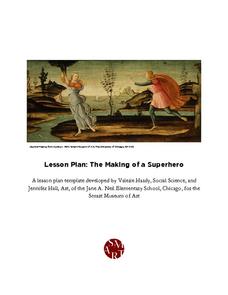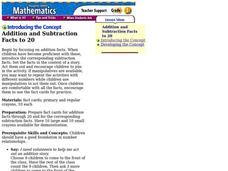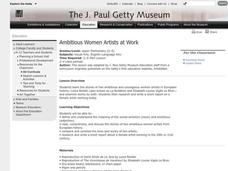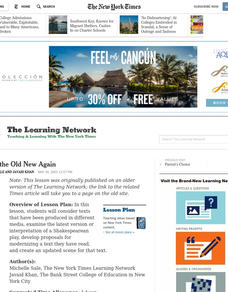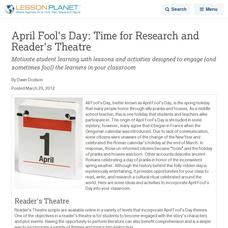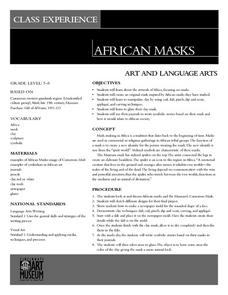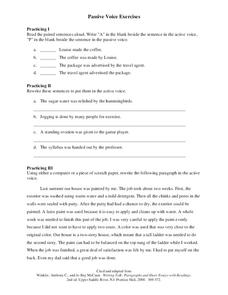Curated OER
Red Riding Hood in China
Inspire young writers to compose their own version of the fairy tale "Little Red Riding Hood." They begin by reading "Little Red Riding Hood" and the Chinese version <i>Lon Po Po</i>, then they compare and contrast the two...
Curated OER
Comparison of Multicultural Literature
Students examine three different versions of "Twas the Night Before Christmas" and complete a comparison activity. Their own version of the poem is created and illustrated in this instructional activity.
Smart Museum of Art
The Making of a Superhero
Thor, Loki, Iron Man, and Captain America. As part of their study of Greek and Roman gods and heroes, middle schoolers compare the characters in The Avengers to Greek counterparts. Individuals then create their own superhero,...
PBS
What Makes A Good Video Report?
As part of a media literacy unit, class members establish criteria for good video reporting, and practice giving both positive (warm) and constructive (cool) criticism.
Newseum
Evidence: Do the Facts Hold Up?
Sometimes it's hard to escape bad information! Pupils learn the E.S.C.A.P.E. method for evaluating news sources and complete a worksheet to assess a news article using their new skills.
Education World
Pilgrim Projects
Finally! Here are some new and fresh ideas, across the curicullum, that can be used around the Thanksgiving holiday. The lesson is divided up into two sections: Beyond Turkey - Activities for Younger Students and, Beyond Turkey -...
Curated OER
Casting Doubt: "Color-blind" and Nontraditional Casting Decisions
In his article about color-blind casting entitled, "Willy Loman Is Lost, Still Looking for Stimulus Plan and Some Dignity," Charles Isherwood quotes August Wilson as saying, "To mount an all-black production of a 'Death of a...
San Francisco Symphony
Learning Adjectives through the Duke
Duke Ellington, jazz, and jive kick-off a fun and creative lesson on responding emotionally to music. The class will learn about jive talk used in the 1920s and the life and music of Duke Ellington. They'll listen to a selection of his...
Houghton Mifflin Harcourt
Addition and Subtraction Facts to 20
First graders act out number stories from number cards. In order to learn about addition and subtraction up to 20 lesson, learners become the manipulatives and line up to show the number stories.
Curated OER
Ambitious Women Artists at Work
Examine the works of Luisa Roldan and Elisabeth Louise Vigee Le Brun. Learners view various pieces of art from each of the artists and read about their lives. They discuss the information and construct a Venn diagram, comparing the two...
Curated OER
Stargirl Lesson
Students read a short novel while filling in a graphic organizer for problem and solution. In this sociology instructional activity, students use a prior knowledge and relate the text to theirselves and to think...
Newseum
Can I Trust the Creators?
It's easy to find information at the click of a mouse, but is it trustworthy? Pupils learn about the E.S.C.A.P.E. acronym for evaluating sources. Next, learners read a news story and evaluate its sources to determine credibility. Last,...
Curated OER
Making the Old New Again
How does a new version of a Shakespearean play change in the adaptation process? Use this New York Times' Learning Network lesson to consider texts that have been produced in different media. Middle schoolers examine the latest...
Curated OER
Civil War Literature Circle
Historical fiction can be a valuable asset when learning about the past. Integrate several novels written about the Civil War into your social studies unit, with groups of four working collaboratively to comprehend the novel from...
Curated OER
Terrific Traveling Tour
Fifth graders discover the career of a museum curator as they assemble mock museum displays and gather information on famous works of art. The lesson is very complete and includes lesson extensions, resource links, and curricular...
Speak Truth to Power
Abubacar Sultan: Children’s Rights
This is an excellent resource for introducing and exploring the topic of child soldiers. Ethics, history, or theology classes will benefit from the high-quality information. This includes detailed instructions for an introductory...
National Endowment for the Humanities
Faulkner's As I Lay Dying: Concluding the Novel
As I Lay Dying is a beautiful book and a wonderful vehicle for understanding, interpreting, and comparing themes. The class reads and analyzes the novel, discusses possible interpretations, and characterizations. They compare the themes...
Curated OER
Happy April Fool's Day!
Grab students' attention with these lesson and activity ideas on April Fool's Day.
Curated OER
Class Experience: African Masks
Students discover the many diverse artwork produced in Africa while focusing upon masks created in tribal groups. They conduct research using a variety of resources and then use the information as samples for inspiration to create their...
Curated OER
States of Matter Lesson
Second graders identify the three phases of matter and demonstrate how a property can change states of matter. In this states of matter lesson, 2nd graders make an Ooze to discover how a solid changes into a liquid. Students...
Curated OER
Passive Voice Exercises
Strengthen understanding of grammar and syntax with this task. First, grammarians identify the active and passive voices, then they rewrite individual sentences to be in the active voice before manipulating an entire paragraph. Great...
Japan Society
Tanabata: Japan's Star Festival
The Star Festival or Tanbata, is a holiday celebrated in Japan every year. People make tanzakus out of paper and hang them on the trees. Pupils will learn about this culturally significant holiday while creating tanzakus of...
Curated OER
Arts have Emotional Impact
Learners explore how various artists use color, line and composition to create a mood. In comparison, students explore various elements of specific art forms that affect the viewer's emotions in dance, theater music and the visual...
Curated OER
How To Make an Apple Pie and See the World
Students have a class discussion on how the variety of foods we use on a daily basis come from all over the world. They identify foods that they are familiar with that come from other places.


